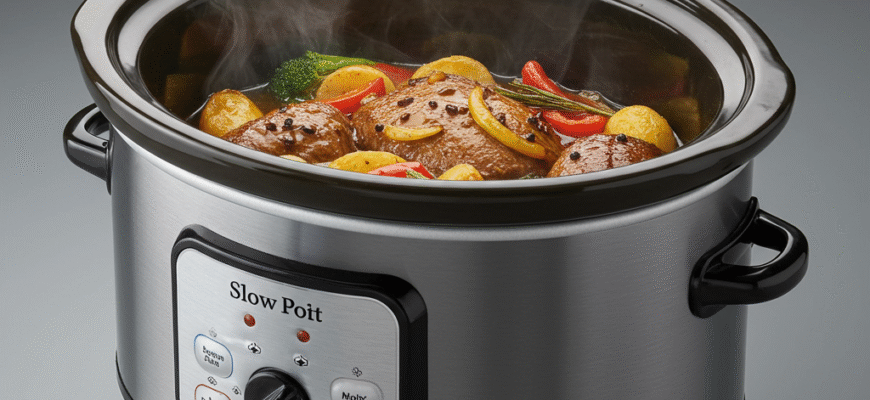Content
The Anatomy of a Slow Cooker
Understanding how a slow cooker works starts with its basic components. Typically, you have three main parts:- The Base: This is the outer shell, usually made of metal, which houses the heating elements and the controls (like Low, High, Warm settings). Unlike a pot on a stove that gets heat from below, the heating elements in most slow cookers wrap around the sides of the base.
- The Insert (Crock): This is the heavy pot, commonly made of glazed ceramic or porcelain, that sits inside the base. It’s where you place your food. This material is chosen for its excellent heat retention and distribution properties – it heats up slowly and evenly, and holds that heat for a long time.
- The Lid: Usually made of glass, the lid sits snugly on top of the insert. Its weight and design create a relatively tight seal, crucial for trapping steam and moisture during the lengthy cooking process.
Gentle Heat, Gradual Cooking
The core principle is gentle, consistent heat. Slow cookers operate at significantly lower wattages than conventional ovens or stovetop burners. When you turn it on, electricity flows to the heating elements embedded within the base. These elements don’t blast the insert with high heat; instead, they gradually warm the air space between the base and the insert. This heat is then transferred slowly and evenly to the ceramic or porcelain crock. Because the heat primarily comes from the sides, surrounding the food, it promotes very even cooking. There are no intense hot spots directly underneath, reducing the risk of scorching or burning that can happen easily on a stovetop, especially with minimal liquid. The heavy insert acts as a heat reservoir, smoothing out any minor fluctuations from the heating element cycling on and off.Understanding the Settings: Low vs. High
Many people assume the ‘High’ setting cooks at a higher final temperature than ‘Low’. This isn’t usually the case. Both settings typically aim for the same target temperature range, which is generally just below the boiling point of water – somewhere around 190 to 210 degrees Fahrenheit (90 to 100 degrees Celsius), depending on the model. The real difference lies in how quickly the cooker reaches that target simmering temperature.- Low Setting: Takes longer to reach the target simmer. This extended period allows for maximum tenderization and flavor melding, ideal for tougher cuts of meat that benefit from many hours of gentle heat.
- High Setting: Reaches the target simmer more quickly, roughly halving the cooking time compared to the low setting. It’s useful when you have less time, but might not achieve the same level of fall-apart tenderness for very tough cuts.
The Science of Transformation: What Happens Inside
The low, moist heat environment created inside the slow cooker works wonders on food, particularly tougher cuts of meat and fibrous vegetables.Breaking Down Tough Tissues
The star of slow cooking, especially for meats like chuck roast, pork shoulder, or brisket, is its effect on collagen. Collagen is a tough connective tissue protein found abundantly in well-exercised muscles. Trying to cook these cuts quickly with high heat often results in tough, chewy meat because the collagen tightens up. However, prolonged exposure to moist heat in the temperature range maintained by a slow cooker works differently. Over several hours, the heat slowly hydrolyzes the collagen – essentially, it breaks it down and converts it into soft, rich gelatin. This gelatin melts into the meat and the surrounding juices, creating that incredibly tender, succulent, fall-apart texture that slow cookers are famous for. It also adds body and richness to the cooking liquid, forming the base for delicious gravies and sauces.Moisture is Key
The tight-fitting lid is crucial. As the food heats up, moisture is released from the ingredients (especially meats and vegetables) in the form of steam. The lid traps this steam, creating a humid environment inside the crock. Some steam condenses on the underside of the lid and drips back down onto the food. This constant basting action does several things:- It prevents the food from drying out, even over many hours of cooking.
- It helps conduct heat efficiently throughout the contents of the crock.
- It concentrates flavors, as very little liquid volume is lost to evaporation compared to stovetop simmering or oven roasting without a cover.
Resist the Urge to Peek! Every time you lift the lid during cooking, significant heat and moisture escape. This can lower the cooking temperature considerably and may extend the required cooking time by 15 to 30 minutes each time. Only remove the lid if absolutely necessary, typically near the end of the cooking cycle to check for doneness or add final ingredients.









